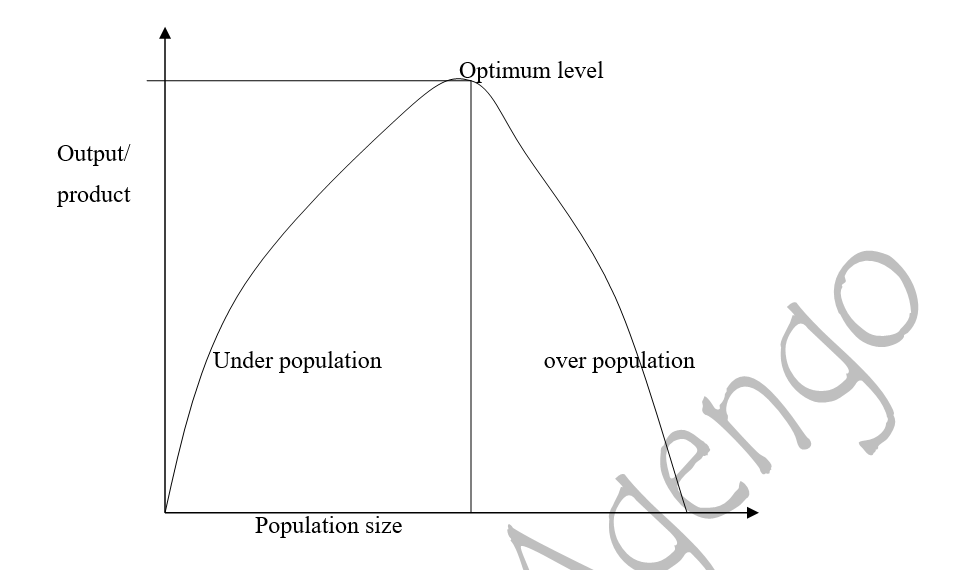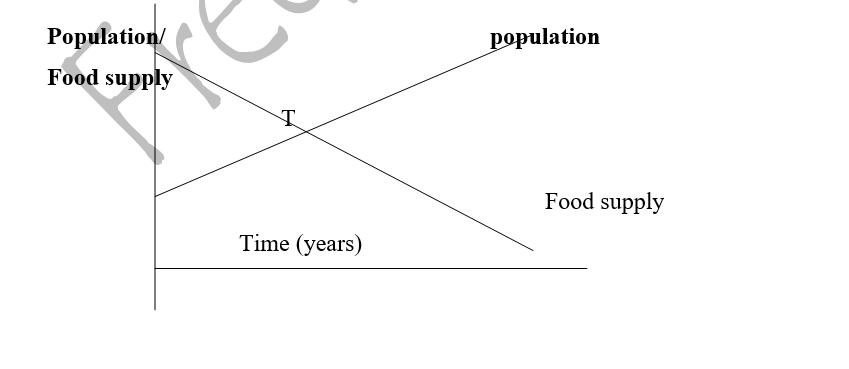Population: refers to the number of people living in a particular area at a specific period of time.
It includes both permanent and temporary residence of a place.
Demography: refers to population composition, patterns and structures in terms of age, sex, occupation and settlement.
Population growth rate: refers to the changes in population size that can be brought about due to changes in migration, births and death rates and other factors.
The difference between the crude birth rate and crude death rate in a country gives as the Natural population growth rate. I.e. CBR- CDR=NPGR
Population explosion: refers to the rapid increase in population in a given area relative to the available resources such that the resources cannot adequately satisfy the needs of people.
Optimum population: It is the population size and structure which is most suitable and conducive for exploitation of available resources of the economy. It is the population size that provides the labour force that when combined with other factors of production e.g. capital, land e.t.c yields the maximum output per worker/average output. It occurs at a level where the average output or output per head of population is at the maximum.
Under population: this is the population size which is too small to effectively use the available resources in an area such that the average product of labour increases with increase in population/workforce. This population size falls below the optimum level where there is insufficient labour to fully exploit the existing resources.
Over population: is a situation where the size of the population exceeds the optimum and available resources is not sufficient to sustain population size such that the average product of labour declines with the increase in population size. It implies that population size is too large to be sustained by the existing resources and it happens when the population size exceeds the capacity of existing resources at given particular technology.
An aging population: this is the population structure in which a bigger percentage is made up of old people. May be caused by the fall in the birth rate and rise in the life expectancy

Declining population: is a situation where population trend is towards smaller families and people try to keep families as small as possible. This leads to the fall of the size of population.
Population census: refers to the enumeration of people living in an area in a given period of time in order to establish the various aspects and structure of the population for planning purposes.
Importance of population census
- To establish the correct size of the population.
- To discover the distribution of the population and also to establish population densities which help in planning and distribution of social services and other resources.
- Helps to establish both birth and death rates that are useful in formulation of population policies.
- To establish the size of labour force, the middle age or economically active and number of dependants (the old, the middle age, the young).
- To establish the quality of the population by establishing the level of education of people.
- To establish rate of migration i.e. immigrants.
- To discover the sex composition in a given population in a country (male and female).
- To establish the rate of unemployment in a country.
- To establish the extent of population variables such as divorce, separation, migration e.t.c. for various purposes.
Population Theory
Malthusian Population Theory
- It was formulated by Rev. Malthus Thomas. He expresses his worries about rapidly increasing population in his essay on population in the year 1798.It states that a population increases faster than food supply and if left unchecked may lead to human misery (state of starvation).It presupposes that man’s biological capacity to reproduce exceeds his capacity to increase the food supply. It further assumes that population grows at Geometric rate/progression (i.e. 2, 4, 8, 16, 32…..) if unchecked can double itself every 25 years. Food supply however increases at arithmetic rate/procreation (i.e. 2, 4, 6, 8, 10……) due to the operation of low diminishing returns based on idea that the supply of land is fixed and the best land is used first and worst is cultivated last. At least step of population growth, Malthus argued that the amount of food produced is often less than even before and that at certain point in time; population growth exceeds food supply. In such a situation the resources would be unable to support a given size of population and any additional population is likely to starve to death, leading to Malthusian population trap.
- The point at which the production of food equals that of population growth is termed population trap.

The point T is the termed population trap where food supply is equal to population growth. Beyond point T i.e. the suggested region is a state of misery (starvation and death).
To avoid entering misery, he suggested two checks on population growth rate:-
- Negative or preventive checks
They are voluntary measures aimed at controlling population growth rate by controlling the birth rate e.g. late marriages, celibacy, restraints.
- Positive checks
Is involuntary control measures aimed at controlling population growth rate by increasing death rates: – e.g.
- Famine
- Diseases
- Wars
- Starvation
- Calamities
Factors that influence population size and structure
- The crude birth rate-Refers to the number of births per annum per 1000 of population
It is crude because it only records live births but doesn’t take into account the infant mortality rate. Increase in this rate will lead to an increase in population size and vice versa.
- The crude death rate-Refers to the number of people that die in a country per 1000 of population. It is crude because it does not take into account the age of a person who dies. If this rate is low the population size is said to be big and vice versa assuming other factors are constant.
- The reproduction rate
It measures the number of daughters that a new born girl would bear during her lifetime assuming that her fertility rate and life expectancy is constant. If the net reproduction rate is high, the population size would be big composing of majority being female and vice versa.
- Infant mortality rate
It records the number of deaths of children below the age of 1 year expressed as number of 1000 of children in that age group per annum. If the rate is low then it implies that the population size would be big and vice versa.
- Fertility rate
It measures the average number of children born per woman during her active child bearing years (15-45 years).If the fertility rate is high then the population size is said to be big and vice versa.
- Marriage patterns
Given that majority of births are to married women, the number of marriages will directly affect the population size. The age at which people marry also influences the population size e.g. if girls get married at younger age then the population is likely to be high. When the population also has preference for big family size then the population size is likely to be big and vice versa.
- Migration patterns
It records the number and way in which people move into and out of a country. If the number of immigrants is more than the number of emigrants population size will be big and vice versa.
- Moral values –If the moral values are observed then the population size will be controlled and vice versa.
Impact of population changes on Economic Development
Effects of an Ageing population
- Leads to greater dependence on the young; it reduces the level of savings in the economy thereby limiting investment thus leading to low capital formation.
- It leads to a small size of labour force
- It leads in changes of pattern of production and consumption of goods; since more goods are produced for the old.
- It decreases labour mobility; an ageing population is less mobile as compared to one dominated by the young.
- Leads to shortage of labour in new industries; economy becomes unable to supply the required labour to both the new and expanding industries.
- It is more conservative and less innovative; it retards the rate of economic development, it may lead to problem of structural unemployment due to the demand for the products of those industries engaged in production for young falls thus some categories of workers may be laid off.
Effects of a Declining population
- It changes the distribution of wealth in the economy.
- It reduces the pressure on key resources of production such as capital, labour.
- It leads to a fall in aggregate demand resulting into smaller markets thus affecting the level of production of goods and services.
- It strengthens the government’s ability to provide essential goods and services.
- It reduces the chances of unemployment; the supply of labour will be low.
Impact of over population
- Problem of inflation
Over population creates imbalance in forces of demand and supply where the aggregate demand exceeds that of supply causing inflationary tendencies as prices constantly rise.
- Existence of unskilled labourforce-The resources/funds may not be adequate or enough to meet the training needs of the population leading to unskilled labour force.
- Over exploitation of resources
- Over strained infrastructure
Overpopulation causes heavy strain on the existing infrastructural facilities e.g. water supply, electricity, roads e.t.c. which cannot cope up with the high demand.
- Land fragmentation; lands have been subdivided thus less production
- Rural-urban migration
People move from rural to urban areas in search for job opportunities. Rapid population increase in the rural centre forces people out of agricultural sector into urban areas in search of good opportunities.
- Leads to low investment level.
Effects of under population in economy
- Resource under utilization
Under population creates insufficient labour force to fully exploit and utilize the existing resources thus leading to low output.
- Low aggregate demand or limited market
The demand for goods and services would be low thereby reducing the size of markets in the economy for most goods and services.
- Low investment resulting to low capital formation
The associated small markets do not stimulate investments in various sectors of the economy especially the industrial sector. Due to low investment level, capital accumulation remains low, leading to low capital formation.
- Results to underdeveloped infrastructure
Under population discourages investments on social and economic infrastructure e.g. roads, schools, power supply e.t.c. this leads to under development of the economy as a whole.
- Slow economic progress
Under population slows down and may as well hinder economic development due to lack of pressure on resources and also because of less competition.
- High transport costs
Under population is characterized by thin population distribution that involves high transport costs hindering trade within areas or regions.
